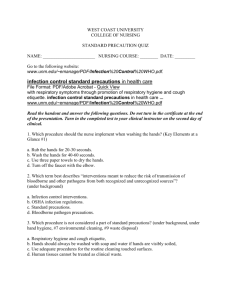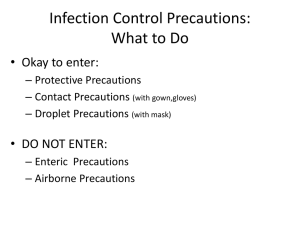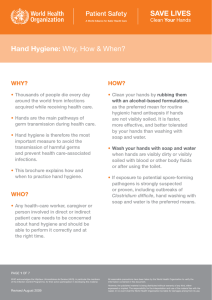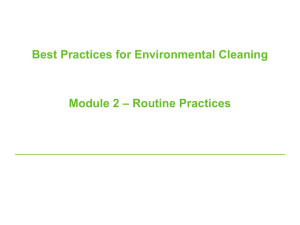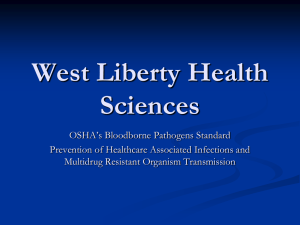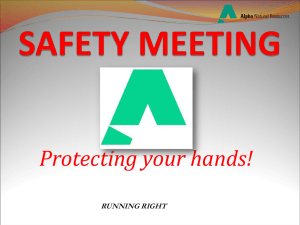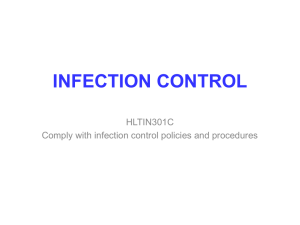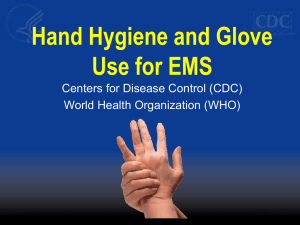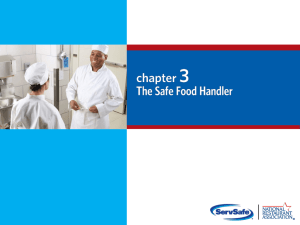Infection Control
advertisement
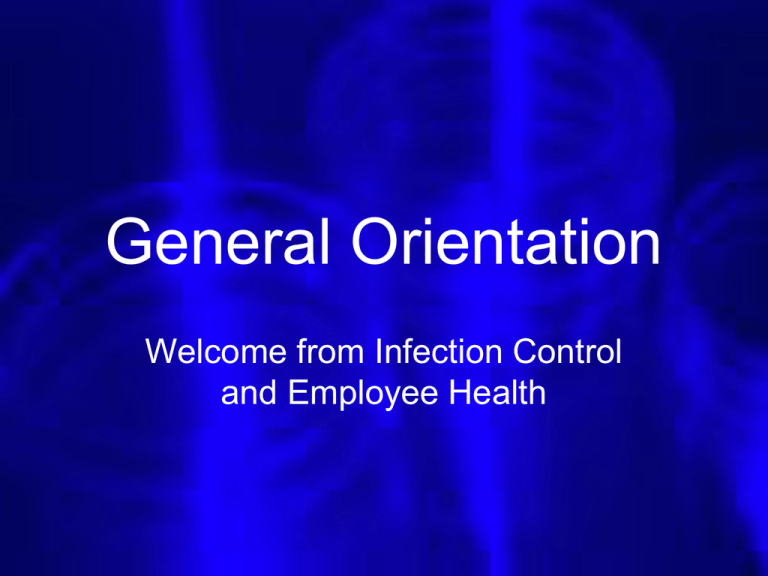
General Orientation Welcome from Infection Control and Employee Health Host Factors • Defenses – – – – – Intact skin Mucous membranes Immune system Good health Immunization • Susceptibility factors – – – – – – Age Heredity Nutritional status Stress Underlying disease lifestyle Signs and Symptoms of Infection Pain Changes in vital signs Tenderness Fatigue Redness Appetite loss Drainage Nausea Diarrhea Vomiting Fever Infectious Agent Susceptible Host Mode of Transmission Modes of Transmission • Direct contact – Touching, bathing, contact with secretions • Indirect contact – Clothing, linen, specimen containers, equipment, dressings • Droplet – Sneezing, coughing, talking • Airborne – Moisture or dust particles that are inhaled • Vehicle – Water, food, blood • Vector – Insects, animals Not a consideration for clinical infection prevention in a healthcare setting Standard Precautions • • • • • Hand hygiene Use of barriers Sharps safety Respiratory etiquette Safe injection practices WHO Hand Hygiene Guidelines • Why? – Healthcare acquired infections account for 99,000 deaths per year in the USA – Hands are the main transmission vehicle – Hand hygiene is, therefore THE most important measure to prevent infections WHO Hand Hygiene Guidelines • Who? – Any health care worker, caregiver, or person involved in direct or indirect patient care – That’s all of us! WHO Hand Hygiene Guidelines • How? – Alcohol hand rubs are the preferred means for routine hand antisepsis – Use when hands are not visibly soiled Faster More effective Better tolerated How to Handrub • • • • Palm to palm Palm to top of hand, interlaced fingers Palm to palm with fingers interlaced Back of fingers to opposing palms with fingers interlaced • Clasped fingers to palm • Rotational rubbing of thumbs Total Time: 20-30 seconds -on the fly! Handwashing • When hands are visibly soiled • After contact with blood or body fluids • After using the toilet Otherwise, USE HANDRUB Handwashing • Turn on tap, adjust water temperature • Wet hands then apply soap • Perform same maneuvers as for hand rubbing • Rinse with water • Dry hands with paper towel • Use paper towel to turn off faucet Total Time: 40-60 seconds at the sink Hand Hygiene Surveillance You can’t manage what you don’t measure Managers held accountable for the rates and trends in their units Individuals held accountable by managers Barrier Precautions Because you never know! If it’s wet, wear gloves! • Gloves act as a barrier between you and the patient’s blood or body fluids • Hand hygiene before and after using gloves – Gloves provide a warm moist environment where the germs on your hands can multiply – 52-63% of gloves leak – Bacteria on your hands can be transferred to surfaces and other people for 3 hours after your gloves are removed if you don’t decontaminate your hands! – Gloves are single use only Removing Gloves 1) To remove a glove, grasp it just below the cuff 2) Pull the glove down over the hand so that it is turned inside out 3) While removing the first glove, do not allow the soiled, outside portion to touch skin 4) Hold the removed glove with other gloved hand 5) Reach inside the other glove at the wrist with the first two fingers of the ungloved hand 6) Pull the glove down over the hand and the other glove 7) Discard both gloves in appropriate container 8) Perform hand hygiene Use fluid shield mask with visor or goggles if splashing likely Wear a waterproof gown if you are likely to get your clothes soiled or wet Wear shoe covers if you anticipate encountering large amounts of blood (OR, L&D) Use face shields, pocket masks or ambu bags to deliver ventilations Proper order of PPE Donning and Doffing Donning (ON) Perform hand hygiene Gown Mask or Respirator Goggles, eye protection Gloves Doffing (OFF) Gloves Goggles, eye protection Gown Mask or Respirator Perform Hand Hygiene Except for respirator (N-95), remove PPE at doorway or in anteroom. Remove respirator after leaving patient room and closing the door. Safe Injection Practices Handle sharps as if your life depends on it (it does!) •Deploy the safety mechanism! •Do not recap, shear or break needles •Be aware that trash or linen may contain sharps that were not disposed of properly Dispose of sharps as if your coworker’s life depends on it •Report any sharps containers that are mounted too high or are not easily accessible •Change sharps containers when ¾ full •Dispose of sharps immediately after use •Remember our housekeepers and laundry handlers!! Practice Good Housekeeping • Clean all equipment and surfaces as soon as possible after contact with potentially infectious materials • 2 minutes kills bloodborne pathogens • 5 minutes (wet) for other germs Practice Good Housekeeping • Do not pick up broken glass with gloved or bare hands • Use tongs, forceps or a brush and dustpan Handle trash and linen as little as possible •Do not sort or rinse linen before bagging Household Trash •Carry trash and linen away from your body •When emptying trash, shake down instead of pushing down Linen •Change bags when 2/3 full Biohazardous Waste What Goes Into Red Bags? • Liquid Blood and Body Fluids (more than 30 mls) • Blood bags and Blood Tubing • Saturated, drippy dressings • Pathology specimens, human tissue • Microbiology Waste, Cultures Cough Etiquette • To prevent spread of colds, flu, SARS and other droplet and airborne infections • Provide materials – Tissues – Mask – Alcohol gel • Provide instructions – Wear mask if within 6 feet of others – Tissue use, disposal – Hand hygiene Precautions for Spinal Procedures • 8 cases of meningitis were linked to oral flora of personnel performing procedures (LP’s, epidurals, spinals, etc) • Providers in those cases were not masked. Transmission Based Isolation Protocols Special protocols for infections other than blood borne. Precautions are to be taken as soon as a disease is suspected Use Isolation Precautions Reference from the IC Manual Patient Safety and Isolation Talk to the patient while you are in the room providing care. Make sure the necessary equipment for isolation is available. Provide the patient with newspapers, books, and magazines, if appropriate. Instruct the family and visitors about the isolation techniques. Frequently check on the patient Place the call bell within the patient’s reach. Contact Precautions Any time the environment is likely to be contaminated Any time you can’t contain drainage/secretions Wounds that you can’t keep covered or that saturate through the dressing Diarrhea in a patient that is incontinent or unable to practice good hygiene When you are dealing with Multi Drug-Resistant Organisms Methicillin resistant Staphylococcus aureus (MRSA) Vancomycin resistant Enterococcus (VRE) C. difficile or other anti-biotic resistant organism (ESBL’s, CREs, etc.) Contact Precautions The Inanimate Environment Can Facilitate Transmission X represents VRE culture positive sites ~ Contaminated surfaces increase cross-transmission ~ Abstract: The Risk of Hand and Glove Contamination after Contact with a VRE (+) Patient Environment. Hayden M, ICAAC, 2001, Chicago, IL. Contact Precautions PPE • Gown and gloves to enter room – Every encounter – Every time • Mask if the organism is in the sputum and the patient has respiratory symptoms C. difficile Resistant to disinfectants • C. difficile Associated Disease can be severe – diarrhea, colitis, toxic megacolon and death • This germ can go dormant as a spore • Alcohol rub, when used with gloves is sufficient hand hygiene for isolated cases • If there is an outbreak • Soap and water washing would be required to remove the germs (alcohol doesn’t kill the spores) • Environmental surfaces would be cleaned with bleach Droplet Precautions • Used for diseased that are spread through droplets when the patient coughs or sneezes • Don the mask to enter the room • Safety zone is 6 feet away from the patient • Common illnesses where we use contact precautions include: Pneumonia Influenza Airborne Precautions • • • • For illnesses transmitted by droplet nucleii Expelled when pt coughs or sneezes When droplets dry, nucleii waft into the air Can be breathed down to the base of your lungs • Examples of diseases: Tuberculosis, measles, chicken pox N95 Respirator required Negative pressure room Required If pt leaves room, surgical mask required Questions? • Office hours are from 8:30-5:00 Monday through Friday • Located on the 1st floor off the Women’s Center Lobby • Ext 1843

